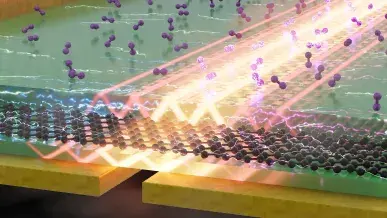Nano-scale molecular detective: New on-chip device uses exotic light rays in 2D material to detect molecules
Researchers have developed a highly sensitive detector for identifying molecules via their infrared vibrational “fingerprint”. Published in Nature Communications, this innovative detector converts incident infrared light into ultra-confined "nanolight" in the form of phonon polaritons within the detector´s active area. This mechanism serves two crucial purposes: it boosts the overall detector´s sensitivity and enhances the vibrational fingerprint of nanometer-thin molecular layer placed on top of the detector, allowing this molecular fingerprint to be more easily detected and analyzed. The compact design and room-temperature operation of the device hold promise for developing ultra-compact platforms for molecular and gas sensing applications.

Molecules have some sort of fingerprints, unique features that can be used to differentiate them. Each type of molecule, when illuminated with the right light, vibrates at a characteristic frequency (its resonance frequency, which typically occurs at infrared frequencies) and strength. Similar to what can be done with human fingerprints, one can exploit this information to distinguish different types of molecules or gases from each other. That can also protect us from potential dangers, by identifying poisonous and dangerous substances or gases instead of criminals.
One conventional approach is infrared fingerprint spectroscopy, which uses infrared reflection or transmission spectra to identify different molecules. However, the small size of organic molecules compared to the infrared wavelength results in a weak scattering signal, making it challenging to detect small quantities of material. In recent years, this limitation has been addressed using Surface-Enhanced Infrared Absorption (SEIRA) spectroscopy. SEIRA spectroscopy leverages infrared near-field enhancement provided by rough metal surfaces or metallic nanostructure to amplify the molecular vibrational signals. The main advantage of SEIRA spectroscopy is its ability to measure and study minute material quantities.
Recently, phonon polaritons—coupled excitations of electromagnetic waves with atomic lattice vibrations—particularly hyperbolic phonon polaritons in thin layers of hexagonal boron nitride (h-BN), have emerged as promising candidates for boosting the sensitivity of SEIRA spectroscopy. "Previously, we demonstrated that phonon polaritons can be applied for SEIRA spectroscopy of nanometer-thin molecular layers and gas sensing, thanks to their long lifetimes and ultra-high field confinement," says Prof. Rainer Hillenbrand from CIC nanoGUNE.
However, SEIRA spectroscopy remains a far-field technique that requires bulky equipment, such as light sources, SEIRA substrates, and typically nitrogen-cooled infrared detectors. This reliance on large instruments limits its potential for miniaturisation and on-chip applications. In parallel, "we have been investigating graphene-based infrared detectors that operate at room temperature, and we have shown that phonon polaritons can be electrically detected and can enhance detector sensitivity," adds Prof. Frank Koppens from ICFO.
By combining these two progresses, a team of researchers has now successfully demonstrated the first on-chip phononic SEIRA detection of molecular vibrations. This result was made possible through the joint experimental efforts of Nanogune and ICFO researchers, along with theoretical support from the groups of Dr. Alexey Nikitin at the Donostia International Physics Center and Prof. Luis Martín-Moreno at the Instituto de Nanociencia y Materiales de Aragón (CSIC- Universidad de Zaragoza). The researchers employed ultra-confined HPhPs to detect molecular fingerprints in nanometer-thin molecular layers directly in the photocurrent of a graphene-based detector, eliminating the need for traditional bulky IR detectors.
"One of the most exciting aspects of this approach is that this graphene-based detector opens the way towards miniaturisation," comments ICFO researcher Dr. Sebastián Castilla. He continues, "By integrating this detector with microfluidic channels, we could create a true 'lab-on-a-chip', capable of identifying specific molecules in small liquid samples—paving the way for medical diagnostics and environmental monitoring."
In a longer-term picture, nanoGUNE researcher and first author of the study, Dr. Andrei Bylinkin, believes that "on-chip infrared detectors operating at room temperature could enable rapid molecular identification, potentially integrated into smartphones or wearable electronics." He further believes that "this would offer a platform for compact sensitive, room-temperature infrared spectroscopy."
Reference:
Bylinkin, A., Castilla, S., Slipchenko, T.M. et al. On-chip phonon-enhanced IR near-field detection of molecular vibrations. Nat Commun 15, 8907 (2024). Featured in the journal's Editors' Highlights
